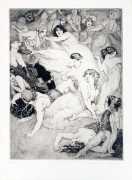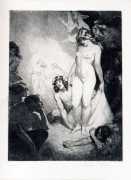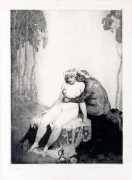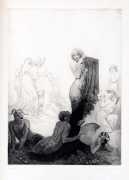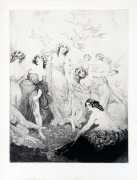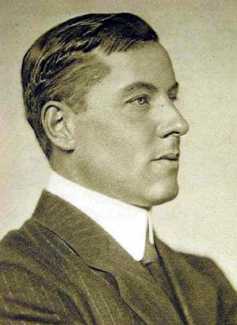
Norman Lindsay had first collaborated with the young Adelaide-born war poet Leon Gellert in 1917, with sixteen of his pen illustrations accompanying Gellert’s text in the successful Angus & Robertson edition of Gellert’s Songs of a Campaign. After his discharge from active service Gellert was quickly accepted into the Lindsays’ intimate inner circle of artist and writer friends. The idea for Gellert’s fantasy The Isle of San had apparently come to him in his dreams. With its poetic landscape saturated with the themes of beauty and the physicality of love, it replaced the nightmare of the horrors of war which would have haunted Gellert since his experiences at Gallipoli, and was ideally suited to the sensuality and sexual power which permeated Norman Lindsay’s aesthetic vision.
Lindsay was greatly impressed by its potential to become a book which would ‘stir in booklovers the lust of possession’. The cycle of fifty-two poems and its illustrations were produced concurrently, Lindsay setting to work with ardour on a small group of etchings for the proposed work, while Gellert honed the text. The five etchings would be printed by Norman’s wife Rose. Despite the recent loss of a child during birth and subsequent septicaemia, Rose was recognised by Norman as the only person capable of printing the etchings precisely as he wanted.
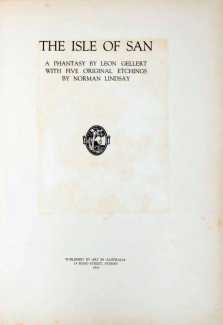 It is thought that The Grey-eyed Girl (the main model for the series) was based on Annie Brennan, the notorious Sydney bohemian and courtesan of legendary beauty and daughter of Gellert’s fellow poet, Christopher Brennan. In a letter to Jack Lindsay, it was even suggested by Ray Lindsay that Annie Brennan was Gellert’s main inspiration for the entire work.
It is thought that The Grey-eyed Girl (the main model for the series) was based on Annie Brennan, the notorious Sydney bohemian and courtesan of legendary beauty and daughter of Gellert’s fellow poet, Christopher Brennan. In a letter to Jack Lindsay, it was even suggested by Ray Lindsay that Annie Brennan was Gellert’s main inspiration for the entire work.
As Norman’s etchings were enjoying a boom, The Isle of San sold out in a single afternoon. The volume is dedicated by Gellert to Sydney Ure Smith and Bertram Stevens, and was printed by Art in Australia, its first deluxe edition, in a numbered limited run of 120 copies.


